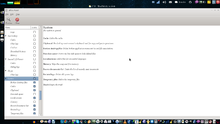BleachBit
 | |
| Initial release | 24 December 2008 |
|---|---|
| Stable release | 1.8
/ 19 June 2015 |
| Repository | |
| Written in | Python |
| Operating system | Microsoft Windows Linux |
| Platform | IA-32 and x64 |
| Size | 6.1 MB |
| Available in | 61 languages[1] |
| Type | Disk cleaner |
| License | GNU General Public License |
| Website | bleachbit |
BleachBit is a free software disk space cleaner, privacy manager, and computer system optimizer.
History
BleachBit was first publicly released on 24 December 2008 for GNU/Linux systems.[2] The 0.2.1 release created some controversy[3] by suggesting GNU/Linux needed a registry cleaner.
Version 0.4.0 introduced CleanerML,[4] a standards-based markup language for writing new cleaners. On May 29, 2009, BleachBit version 0.5.0 added support for Windows XP, Vista, and 7.[5] On September 16, 2009, version 0.6.4 introduced command line support.[6]
BleachBit is available for download through its website and the repositories of many GNU/Linux distributions.
As of October 15, 2009, BleachBit was more active than 99.972% of projects on SourceForge,[7][citation needed] and according to the Ubuntu Popularity Contest[8] BleachBit was more popular than 93.44% of installed packages.
Features
- Identifying and removing Web cache, HTTP cookies, URL history, temporary files log files and Flash cookies for Firefox, Opera, Safari, APT, Google Chrome
- Removing unused localizations (also called locale files) which are translations of software
- Shredding files and wiping unallocated disk space to minimize data remanence
- Wiping unallocated disk space to improve data compression ratio for disk image backups
- Vacuuming Firefox's SQLite database which suffers fragmentation
- Command line interface for scripting automation and headless operation
Technology
BleachBit is written in the Python programming language and uses PyGTK.
Most of BleachBit's cleaners are written in CleanerML,[9] an XML-based markup language for writing cleaners which is an open standard.[10] CleanerML does not only deal with deleting files, but also executes more specialized actions such as vacuuming an SQLite database (used, for example, to clean Yum).
BleachBit's file shredder uses only a single pass[11] because of the lack of evidence that multiple passes, such as the 35-pass Gutmann method, are more effective. However, multiple passes are significantly slower and may give the user a false sense of security by overshadowing other ways privacy may be compromised.
See also
References
- ^ "Features | BleachBit". bleachbit.sourceforge.net. BleachBit. Retrieved 13 February 2013.
- ^ http://bleachbit.blogspot.com/2008/12/bleachbits-public-debut.html
- ^ http://lwn.net/Articles/313679/
- ^ http://bleachbit.blogspot.com/2009/02/bleachbit-040-cleaner.html
- ^ http://bleachbit.blogspot.com/2009/05/bleachbit-050-released.html
- ^ http://bleachbit.sourceforge.net/news/bleachbit-064-released
- ^ "SourceForge: Most Active Projects for Last Week - Updated Daily". Retrieved 16 October 2009.[dead link]
- ^ http://popcon.ubuntu.com/
- ^ http://bleachbit.svn.sourceforge.net/viewvc/bleachbit/trunk/cleaners/
- ^ http://bleachbit.blogspot.com/2009/02/cleaner-markup-language.html
- ^ http://bleachbit.blogspot.com/2009/06/validating-secure-erase.html
External links
- BleachBit project page at SourceForge
- Review by Downloadsquad (June 9, 2009)
- Review by SoftPedia (September 16, 2009)
- Review by CNET (January 19, 2011)
